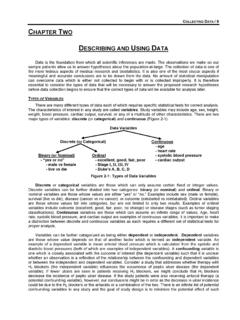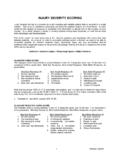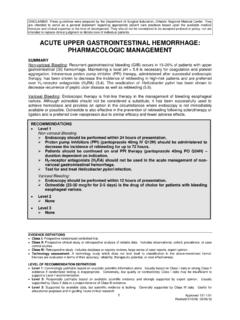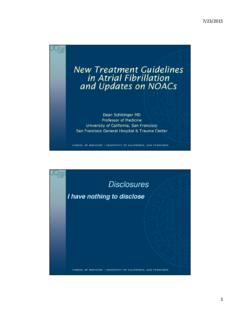Transcription of Warfarin Reversal Guideline 2012 - SurgicalCriticalCare.net
1 DISCLAIMER: These guidelines were prepared by the Department of Surgical Education, Orlando Regional Medical Center. They are intended to serve as a general statement regarding appropriate patient care practices based upon the available medical literature and clinical expertise at the time of development. They should not be considered to be accepted protocol or policy, nor are intended to replace clinical judgment or dictate care of individual patients. Warfarin Reversal Guideline . SUMMARY.. Warfarin (Coumadin ) is used to treat a number of hypercoagulable disease states. Since each patient responds differently to the same dose, this medication carries a high risk of bleeding. Some patients may ultimately require Reversal with either phytonadione (Vitamin K), fresh frozen plasma (FFP) or both. The American College of Chest Physicians (ACCP), American Heart Association (AHA), and the American College of Cardiology (ACC) have developed evidence-based medicine guidelines for the Reversal of Warfarin with FFP and/or Vitamin K.
2 RECOMMENDATIONS. Level 1. Fresh Frozen Plasma (FFP) should be used for emergent Reversal of elevated INRs. Level 2. dosing of phytonadione (Vitamin K) should be based on the patient's current INR, risk of bleeding, and future need for anticoagulation (Tables 1 & 2). Reversal of Warfarin with Vitamin K should be reserved only for the most serious bleeding events or patients who will not be restarted on Warfarin . Vitamin K should be administered either orally or intravenously (IV) only. Oral Vitamin K is the safest and most reliable route. IV Vitamin K should be reserved for rapid Reversal in serious bleeding events only. Subcutaneous and intramuscular administration of Vitamin K should be avoided. Level 3. Initial dose of FFP based on risk of bleeding: Low to moderate risk FFP 2 units High risk or active bleeding FFP 4 units INR should be rechecked 1 hour after administration of FFP. Prothrombin Complex Concentrate (PCC) should be administered to patients on Warfarin with an INR >2 AND evidence of intracranial hemorrhage on CT scan (Table 3).
3 FEIBA NF 1000 units (one vial) IV push over 5 minutes Check INR 30 minutes after administration Vitamin K should not be administered to patients with prosthetic heart valves, only low doses (1mg) should be used if absolutely necessary. The use of recombinant Factor VIIa may be considered in patients with multi-system INTRODUCTION. The use of vitamin K antagonists ( Warfarin ) has been well described in the literature for the treatment of a number of different hypercoagulable states (1-5). However, use of this agent is associated with increased bleeding and poor outcomes in traumatically injured patients. The ACCP, AHA, and the ACC all collaborated on the development of recommendations for Warfarin Reversal for supratherapeutic INRs (1- 5). These recommendations include the use of either fresh frozen plasma (FFP) and/or vitamin K. EVIDENCE DEFINITIONS. Class I: Prospective randomized controlled trial. Class II: Prospective clinical study or retrospective analysis of reliable data.
4 Includes observational, cohort, prevalence, or case control studies. Class III: Retrospective study. Includes database or registry reviews, large series of case reports, expert opinion. Technology assessment: A technology study which does not lend itself to classification in the above-mentioned format. Devices are evaluated in terms of their accuracy, reliability, therapeutic potential, or cost effectiveness. LEVEL OF RECOMMENDATION DEFINITIONS. Level 1: Convincingly justifiable based on available scientific information alone. Usually based on Class I data or strong Class II. evidence if randomized testing is inappropriate. Conversely, low quality or contradictory Class I data may be insufficient to support a Level I recommendation. Level 2: Reasonably justifiable based on available scientific evidence and strongly supported by expert opinion. Usually supported by Class II data or a preponderance of Class III evidence. Level 3: Supported by available data, but scientific evidence is lacking.
5 Generally supported by Class III data. Useful for educational purposes and in guiding future clinical research. 1 Approved 10/17/2006. Revised 08/31/2009, 01/03/2012. (phytonadione) and are summarized in the tables below (1-7). While the dose of vitamin K for specific clinical situations and/or INR levels is clearly defined in the guidelines , the dosing of FFP remains practitioner-dependent. The goal of this Guideline is to provide guidance for the dosing of both vitamin K. and FFP for the emergent Reversal of elevated INRs. Fresh Frozen Plasma (FFP). The use of FFP for emergent Reversal of elevated INRs in the presence of bleeding or high risk of bleeding has been well described in the literature. The appropriate dose of FFP to achieve the desired Reversal of the INR has not, however, been clearly delineated. (Class II) Makris M, conducted a prospective, observational study of 41 patients who required emergent Reversal of their supratherapeutic INR. The patients were reversed with either FFP or clotting factor concentrates.
6 Twelve patients received FFP. These patients had a mean pre-treatment INR of and a post-treatment INR of They received approximately 800 mL FFP (approximately 3 units). All patients were also given vitamin K 1-5mg intravenously. The authors concluded that FFP was effective in lowering the INR through the replacement of Factors II, VII and X but did not significantly change Factor IX. For this reason, they concluded that the use of clotting factor concentrates provides a greater overall Reversal (8). (Class III) Goldstein conducted a retrospective chart review to evaluate the influence of time to FFP. administration on the ability to correct elevated INR levels in patients admitted with Warfarin -related intracranial hemorrhage. Sixty-nine patients were included in the analysis, 40% of which were on Warfarin for atrial fibrillation. The patients baseline INR was > 2 in 88% of the patients. The patients received a mean of 4 units (range 2-6 units) of FFP to achieve Reversal within the first 24 hours compared to a mean of 2 units (range 1-5 units) for patients requiring > 24 hours to achieve an INR < Patients who achieved Reversal of INR within the first 24 hours of hospitalization had a shorter time to administration of FFP (median 90 minutes versus 210 minutes, p = ).
7 However, there was no overall difference in mortality or Glasgow Outcome Scale score (9). Based on the information available, both time to administration (limited by thawing time) and dose of FFP. play a role in rapid Reversal of elevated INR levels. From the studies presented above, 3-4 units of FFP. are needed to decrease an INR. Vitamin K. (Class I-II) Multiple articles as well as the practice guidelines set forth by the ACCP, AHA, and the ACC. provide recommendations for dosing of vitamin K (1-7). The lowest possible dose should be used, especially in patients for whom re-anticoagulation will be necessary at a later date (5-7). dosing of vitamin K is provided in Tables 1 and 2 below. Oral administration of vitamin K is preferred and provides the most predictable response to therapy (5). Intravenous vitamin K should be administered slowly (over at least 30. minutes) to avoid potential anaphylactic reactions (5). Subcutaneous and intramuscular administration of vitamin K should be avoided due to erratic absorption.
8 Reversal of elevated INRs with vitamin K takes approximately 24 hours for maximum effect, regardless of the route of administration (5). Factor VII. The use of recombinant Factor VIIa (rFVIIa) for rapid Reversal of supra-therapeutic INRs remains controversial. There are questions related to assessment of efficacy through changes in the INR. There are also safety concerns due to the risk of thromboembolic events following treatment with rFVIIa (10). To date, there are currently no prospective, randomized controlled trials on the use of rFVIIa for traumatically injured patients on Warfarin . The data is limited to one prospective, observational study, a retrospective study and a few case reports (11-14). There are also a few retrospective studies on the use of rFVIIa for Warfarin Reversal in patients with spontaneous intracranial hemorrhage (15). (Class III) The use of rFVIIa is not without potential thromboembolic complications. O'Connell found 431 reports of adverse drug events related to rFVIIa over a five year period.
9 Of these events, 185 events (in 168 patients) described thromboembolic complications including cerebrovascular events, myocardial infarctions, arterial thromboses, pulmonary embolism, other venous thromboembolism, and clotted 2. devices. The mortality rate in these patients was 30% (50/168). Thirty-six of the 50 deaths (72%) were attributed to the thromboembolic event (10). (Class II) Dager conducted a prospective, observational study of 16 patients on pre-admission Warfarin who were treated with rFVIIa. Each patient received rFVIIa IV (range 11-25 mcg/kg). Eleven of the 16 patients were either trauma (9 patients) or general surgery patients (2 patients). The mean initial INR = which was significantly reduced to a mean INR = post-rFVIIa (p < ). Six of the 16 patients died (38%) primarily from multi-organ system failure. All patients received FFP (range 600-2400mL) either before, during, or after administration of rFVIIa. Ten of the 16 patients also received vitamin K (either 5 or 10mg doses given SQ, IM, or IV) (11).
10 (Class III) Ilyas conducted a retrospective review of patients receiving Warfarin who sustained traumatic brain injuries. They evaluated 24 patients who received rFVIIa compared to 30 historical controls. Patients were treated with a range of rFVIIa doses (10-100 mcg/kg) in addition to a mean of 4 . units of FFP and 5-10mg of intravenous (IV) vitamin K. The control group patients received a mean of units of FFP plus IV vitamin K. There was a shorter time to INR correction in the rFVIIa group ( hours compared to hours). In this small sample, they detected a relationship between dose and duration of INR correction larger doses provided longer duration. There was one instance of myocardial infarction related to the administration of rFVIIa (12). (Class III) Yusim published a case series of three patients treated with rFVIIa following traumatic brain injury. One of these patients was a 79 year-old male on Warfarin for atrial fibrillation. This patient received rFVIIa 34 mcg/kg IV pre-operatively instead of FFP or vitamin K.












